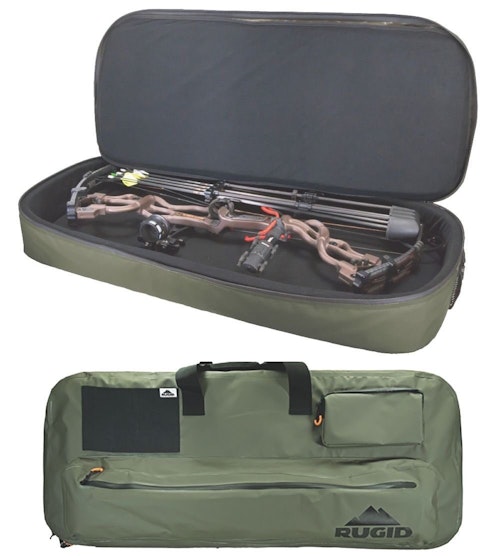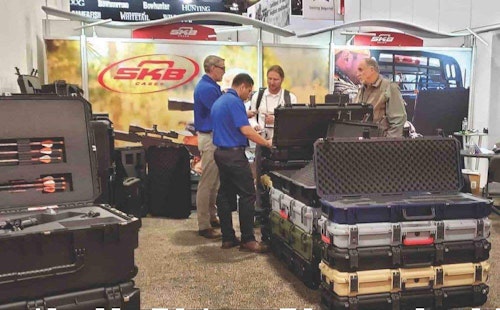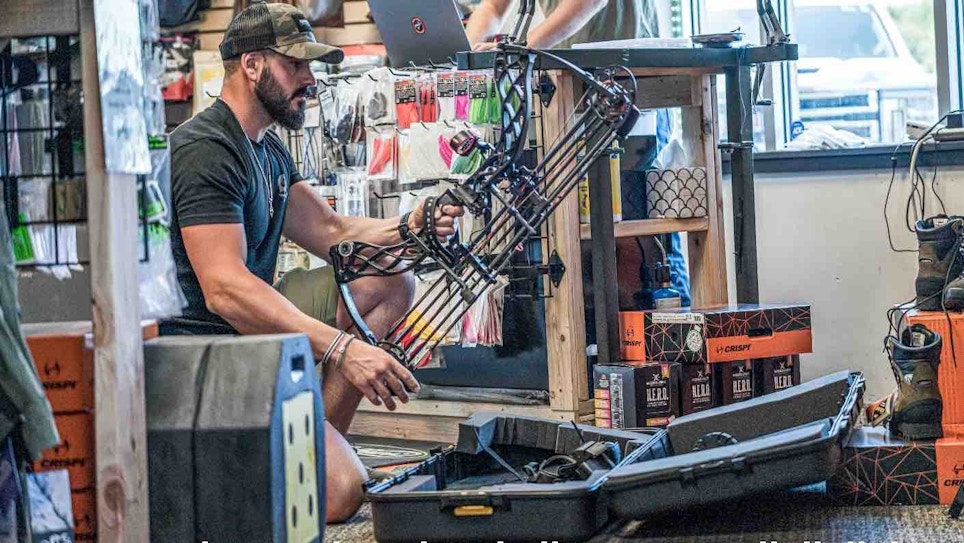I noticed the guy standing beside me in the airport baggage area had a camouflaged daypack, wore hunting boots, and he wore a hat with the logo of a leading bow manufacturer. When my bow case slid down the luggage ramp, he took notice and soon we were talking about archery hunting. Suddenly, I spotted a compound bow — it was wrapped in cardboard and taped from various angles — as it slid down the luggage ramp. Wow, the limb ends and cams were fully exposed to the perils of airline baggage handlers. Yikes! That other hunter picked up his cardboard-wrapped bow and then moved on to join his friends.
I was in disbelief — that someone would check a bow in this manner, and the bow actually arrived in one piece.
It’s a fact that all archery customers need a bow case. Some states require it when a bow transported in a vehicle. And even in states without this regulation, travel with a bow can often be a dangerous undertaking — for the bow.
Are you and your staff making a case for cases with your customers?
Those Perfect Periods
The first time to make a bow case sale depends greatly upon the calendar and a current sale-in-progress. There are optimal periods when customers will likely consider making a bow case purchase:
- as the customer is buying a new bow and accessories
- the month and weeks before your region’s fall archery season opener, plus the spring bear seasons
- the August and September period as bowhunters prepare to travel to hunt
- the beginning of your area’s 3-D tournaments and hunting season preparedness
- the holiday season when family members seek gifts for the hunter who has everything.
As you can see, it’s easy to find a time to start the bow case conversation with customers, especially when they have spent big bucks on a new bow, or mention they are traveling to another region, state or country to hunt with — or compete with — a bow. If a customer has spent a lot of money on a bow, it’s commonsense to spend a little more to protect that purchase.
“You are protecting your investment with a bow case, and it’s why more and more cases are catching on,” said Jeff Bruss with RGD. “Our cases are made for protecting bows from the elements like dirt and debris.”
If the customer also mentions using an ATV when bowhunting, here is the opportunity to hop into the conversation and mention hard and soft bow cases that will protect that archery equipment and gear for the trip to the treestand — to fight against mud and debris plus as those pesky tree limbs and brush that get caught in cables and cams and cause missed shots.
Listen also to customers who mention flying to a hunting destination. This is your opportunity to mention any airline-approved bow cases you have in stock or offer. For flights, it’s best to mention hard side (generally polymer) with aluminum or other metal sturdy frames, plus sturdy hinges and hasps. Some hard cases have locks built into the closures, and others permit the use of standard locks. Customers like options.
Along with the bow case itself, mention options you stock for arrow and accessory storage. One mandatory item is a sturdy arrow box because no one wants arrows, especially those equipped with broadheads, flopping around inside a bow case. Some bow cases have room for arrow boxes inside, while other cases have pockets on the exterior for arrow box storage.
It’s also important to note that hard cases hanging high on a wall, or sitting on the floor behind your archery counter, are not in favorable purchase mode with customers. The same goes for those cases inside boxes in the back storage room. Get ‘em out and get ‘em seen. Create impressive displays that catch shoppers’ attention and provide easy access for hands-on experiences. Remember the previously mentioned peak sales opportunities for cases, and work cases into your advertising plans and special promotions.
If you have cases, customers will come shopping. And once a customer has her or his hands on a bow case, you are on the road to making a sale.

Guide Employees in Sales Pointers
It’s important to guide your employees in bringing up the bow case conversation, and on the specific points that gain a customer’s full attention.
There are numerous bow case features that should be addressed with customers, including: padding inside to protect the bow and accessories (and if this padding can be removed); a case that is lockable; if the case has straps to secure the bow in place; and has a place or space for arrows and accessory storage. Call out if a case is equipped with straps for over-the-shoulder carry, has comfortable handles, and even wheels.
In addition to coaching your employees about the features of cases in your store, remind them about those prime times to bring up the topic.
If a customer mentions heading to Alaska to hunt with a bow, take note. A trip to the 49th state almost always involves flying into base camp — another option is taking a boat through a system of rivers or lakes. Whatever the situation, a bow case is a must. In fact, it might make sense to take two different cases on such an adventure.
“The RGD Floater bow case would be perfect for this; it floats,” said Bruss. “This would be a top mention if the customer is going moose hunting in Canada or Alaska and will be floating down rivers in a boat or canoe.”
If the customer will be flying, and then hunting, suggest a soft case for the bow that will fit inside a hard case. This is often the best of all worlds because this setup provides the customer with more options. While soft bow cases are great for many nearby hunting jaunts without flights, customers should be steered toward hard-sided airline-approved cases if they will be flying. This is also a good time to mention that some outfitters prefer that customers leave hard-sided bow cases in the lodge, then use soft cases when in the field and hunting.
“Another big benefit is our bow cases are designed to fit inside most hard cases, and in many uses the customer simply removes the foam padding from their hard case and puts their bow inside our case and then into their hard case for travel,” continued Bruss. A large number of traveling bowhunters know the many advantages of this setup.

Large, hard-sided bow cases designed for airline travel should have wheels (call this feature to customers’ attention) because the norm is to pack hunting clothing inside the case around the bow. This allows the user to fill the bow case with enough weight to almost reach the maximum allowed (50 pounds for most airlines) before having to pay overweight charges. This way the user can pack a large duffel with another 48 or 49 pounds, and pay for two checked bags (one bow case, one duffel). Of course, the hunter will also have a carry-on bag — usually a camo backpack, which will be loaded with additional gear such as an expensive binocular and rangefinder. Bow case wheels are especially important for older customers who could struggle to get through those mega airport lobbies or when loading luggage at home.
Your designated bow case display center is the best location to sell straps, luggage tags, and other general travel items. One last pointer on serving traveling bowhunters: Keep storage boxes for bow cases and offer these to customers who purchase a bow case. (Cut taping and fold the boxes flat.) More and more hunters ship gear to their final destination to avoid airport hassles and dealing with uneducated counter clerks. A cardboard shipping box for the exact case they are considering purchasing from you might just be the final step in helping them say “I’ll take it.”

Final Thoughts
It pays to scout nearby big box stores and other archery shops to determine which bow cases they sale. Call out products online — and in stock — that you have now and that your competitors are lacking. If a customer is interested in a bow case or committed to the purchase, also point out other similar category products you offer, such as a sturdy arrow box to protect arrows. Many archers also like to be organized and use small tackleboxes for tools, field points and other accessories that could easily fall out of some larger cases or get lost among other packed items.
Don’t forget to stock and display cases for crossbow hunting — a growing market segment as America ages and as more states allow crossbows during standard archery seasons. Have these stocked and out on the show floor. Again, the first step in making a sale is to have the item in a location where customers can see it and get their hands on it. If a customer mentions crossbow hunting, you could be on the way to a sale.
If your retail business sells ATV accessories, then always put a bow case that can be strapped to the front or rear racks on an ATV in that accessory floor space. This can be another strong conversation starter.
There are many points to engage your customers about their need for a bow case. Listen to customers, begin the bow case conversation, and offer a case for buying a bow case. The sale can be more about calling attention to product features than a full-scale pitch.

Sidebar: Zip Up the Details
Everyone in your retail center should be prepared to answer specific questions, beyond price, on products and also provide details that can help customers make informed decisions. Details can also encourage a purchase.
Example: Many hard-sided SKB bow cases have the inner foam that provides protection for a bow, but this foam is also pre-cut to accommodate an accessory box the company sells. So, pointing out to a potential buying customer that they can easily pull out and remove the foam and then insert the accessory box into the open space could signal a strong benefit — plus a sale. Another selling point is the accessory box can now be locked inside the case along with the bow. It’s great news for traveling hunters and archery competitors.
For more details that can help you sell products, ask manufacturer reps who come to your site to give presentations to employees about product specifics and less-than-noticeable features, and share product spec sheets that come with catalogs and packaging with your employees. Details help ring the cash register.






